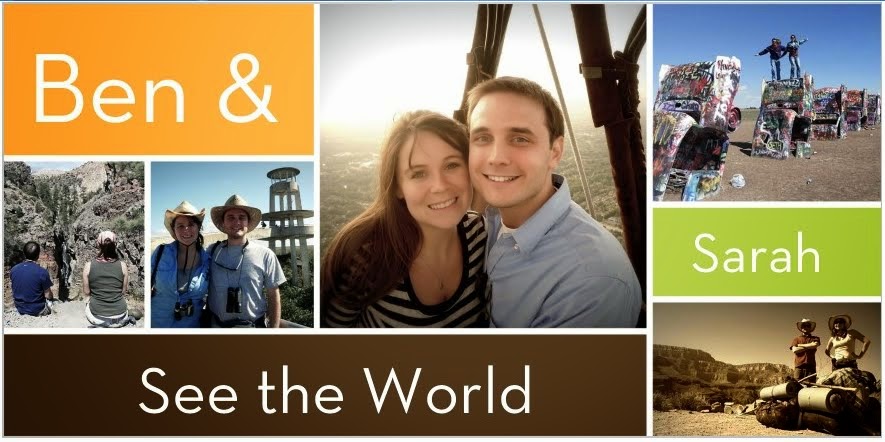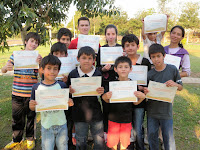So we decided to that the best way to accomplish most of our goals for the community was to start an environmental youth group in Coronel Bogado. The name was pretty easy to come up with. Bogado Verde. Plain and simple. Green Bogado. It went hand-in-hand with the name of the country-wide camp that Peace Corps puts on every year named Paraguay Verde.
We started by inviting kids from our English class to come to the plaza every Wednesday night and every Saturday morning. We also invited kids for the high school we work at and kids from the Scouts. On the first day, a 60 year old woman named Sixta came and helped us pick up garbage. She was the nicest lady ever, and we talked a lot about how the community needs to be cleaned more and how she wants to see people take more pride in the nature of the town. As we picked up trash in the entrance to the peatonal, Sarah and I taught her little expressions in English, like "I don't like trash!"

The second meeting was one of the only times when no one showed up. But over the next couple of weeks, we had more and more people come. Sixta brought her daughter to help, Juan came and brought his sister and his friend, 3 random guys who lived fairly far away starting coming to every activity that we had. And so it went. We were growing! And we were joined by members from another environmental group that started a couple of weeks after ours.
Our friend Hugo studied English for several years and even travelled to the US as a Youth Ambassador of Paraguay. He got to visit California and Washington, DC and see a bunch of cool stuff that I've never even seen before! This kid is 17 by the way. As part of his project, he has to come back to his community and implement a program or activity that will help the people of the community. So he decided to start an environmental youth group that consisted of English classes and environmental activities.
At one of our meetings, we had 16 kids show up and help clean around the park. Wow! That's a lot of kids! Both groups were growing and really making a name for themselves. At one point, Hugo made T-shirts for his group and put a logo for our group on them. It was really awesome; each of our groups had eachother support because we both started at relatively the same time.
So, then we started doing weekly workshops. Our go-to activity has always been glass-making with old wine bottles. You take a bike brake cable and tie some sticks to it, then you wrap the wire around the bottle and alternately pull each side of the wire. The friction of the wire will make a thin line around the bottle super hot, and then you place the whole bottle in ice water. This causes the bottle to break perfectly and PRESTO! You've got yourself a free glass (just sand down the sharp edges). Sarah and I still swear that we are never going to buy glasses again when we come back to the states.
 We did this activity several times in the plaza and once at the old train station. We've people and kids of all ages stop by in the park and give it a try. Most people don't believe that it can be done at first. Every time we prep for the activity, most people look very skeptical, smiling and giving us the "are you sure?" look. But it always makes me really happy to have the bottle break perfectly when placed in the water and have kids get really excited about it. I will never forget the looks on these kids faces when they see this happen. :)
We did this activity several times in the plaza and once at the old train station. We've people and kids of all ages stop by in the park and give it a try. Most people don't believe that it can be done at first. Every time we prep for the activity, most people look very skeptical, smiling and giving us the "are you sure?" look. But it always makes me really happy to have the bottle break perfectly when placed in the water and have kids get really excited about it. I will never forget the looks on these kids faces when they see this happen. :)Ok, let's see, here is a random list of other avitivites that we've done for our workshops: Making bracelets out of old grocery bags, planting trees, planning a bottle top mural of the world, building a trash can out of wire and empty plastic bottles, making eco-bricks... I can't even remember them all!
We created a page on facebook: https://www.facebook.com/BogadoVerde. After about 7 months we have 283 likes (me gustas)!
So, this was our group that we created, fulfilling Goal 1 set forth by our Environmental Conservation program here:
Goal 1: Paraguayan youth will engage in environmentally responsible activities which contribute to the conservation and protection of the country's environment. (Starting youth groups, doing activities, etc.).
An interesting thing to point out is that our number-one goal here is to focus on youth in the country. This is of course because the older generation is less likely to change, but if we focus our awareness campaigns towards youth, we are more likely to make an impact. This always makes me think of a great little metaphor that we heard during training; that we are planting trees whose shade we will not get to sit under. This is true because these kids might not immediately go and be the most super environmental people, but they might always remember those little green things they did growing up and those two weird people for the states who were always talking about how great the environment is, and hopefully these people will wind up leaders in their communities and in the country itself.
Alright, well that's pretty much it. If you're reading this, and you have any questions about our work, feel free to ask!













































